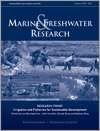Marine and Freshwater Research
Volume 70
Number 9 2019
RESEARCH FRONT: Irrigation and Fisheries for Sustainable Development
The water–food–energy nexus is central to sustainable development. Demand for all three is increasing, driven by a rising global population, rapid urbanisation, changing diets and economic growth. In response, many countries are expanding irrigation infrastructure to produce food, and building dams to secure water and generate power. In some instances this can create pressure for other food resources, such as fish. This research front explores the concept that irrigation and fisheries must advance collaboratively if the Sustainable Development Goals are to meet their intended goals of no poverty and zero hunger.
Irrigation must change to contribute to multiple sustainable development objectives. Most current modernisation programs tend to focus on enhancing system infrastructure and fail to consider other objectives. Safeguarding and enhancing fisheries (which support food, nutrition and livelihood benefits) provides an entry point for a more desirable form of modernisation, contributing to sustainable agriculture and delivering better outcomes across many objectives.
Irrigated agriculture and inland fisheries both provide important opportunities to improve nutrition, livelihoods and wellbeing. However, interventions intended to increase agricultural productivity can often put these two sectors at odds. We contend that the sustainable development goals can serve as a framework to implement more holistic management to improve agriculture, inland fisheries and the economic, environmental and social benefits they both provide to human wellbeing.
Water planners and managers have a unique opportunity to design and manage irrigation for multiple uses. Results from rice–fish farming experimental trials in Myanmar’s Ayeyarwady Delta are providing an evidence base for the importance of integrating fish in the system to increase employment, incomes and the nutritional value of farm plots (alongside associated reductions in pesticide pollution) and improved water use.
Irrigated agriculture and maintaining inland capture fisheries are both essential for food and nutrition security in Myanmar. However, irrigation infrastructure creates physical barriers that block migration routes, and affect inland capture fisheries. For Myanmar to meet sustainable development targets, solutions are needed that decrease negative effect of infrastructure and increase working across sectors for multi-objective benefits from irrigation water use.
Anthropogenic land use activities affect the quality, quantity and habitat of freshwater ecosystems. In South Africa, legislation has been established to balance the use and protection of resources. River connectivity and fish migrations have, however, not adequately been addressed. This appears to be a shortcoming of the existing policy. This paper considers the importance of these processes in resource management.
The probability of successful management of fish resources in a reservoir is high for several reasons: there is the possibility to develop strategies that have clear spatial boundaries, the existence of fishermen’s associations, the reservoir provides a complete ecosystem for an increased fish population, aquaculture activities can support management and restocking is possible. In addition, monitoring and surveillance of the fish population is logistically easier in a reservoir.
Irrigation modernisation is booming globally because of the increasing demand on water and food. However, irrigation infrastructures can injure fish or entrain them into irrigation water. Screening is an effective method to mitigate fish entrainment. Using two sensor devices we demonstrated that a unique horizontal screen can provide safe downstream passage for fish at irrigation diversions.
The paper describes the development of a decision support tool that allows a short-hand analysis of the benefits and costs of constructing fishways that are less than 6 m in height in the lower Mekong River. The tool is underpinned by economic benefit–cost analysis and is the first to be formally developed using local engineering expertise and published information on fish ecology. The tool offers an extension by generating estimates that relate to nutrition, primarily because fish play such an important part in the diet of people in the region.
Murray cod are the target of environmental water because populations have declined. We developed a life history model and applied environmental flows from 2008 to 2018. Fish abundance increased after the perennial environmental flows which also included no rapid water level drops, maximised hydrodynamic complexity and an annual base winter flow. Incorporating hydraulics into environmental flows helped restore an imperilled fish species.
Ichthyodinium chabelardi is a widespread parasite of fish eggs and larvae which can be responsible for large losses in environmental or farmed fish populations. Here we describe what is known about the life cycle, geographic distribution, and host range of this parasite as well as strategies currently in use to control its pathogenicity in farmed fish.
A combination of hydrogeochemical and GIS tools was used to evaluate groundwater quality of coastal aquifers in semi-arid environment. The results showed that the flagship ions in the study area are Cl, Na, Ca and Mg. For consumption purposes, all ions presented concentrations below the threshold, except for chlorides. For the agricultural purposes, groundwater is adequate for persistent plants with a high to very high salinity tolerance.
We explored how different abiotic drivers influence recruitment dynamics of silver perch in the Murray River, Australia. An assessment of age structure data revealed silver perch recruited across highly variable conditions. The strongest year classes were associated with average river discharge and high water temperatures during spawning, followed in the next year by widespread flooding that enhanced the survival of juvenile fish.





